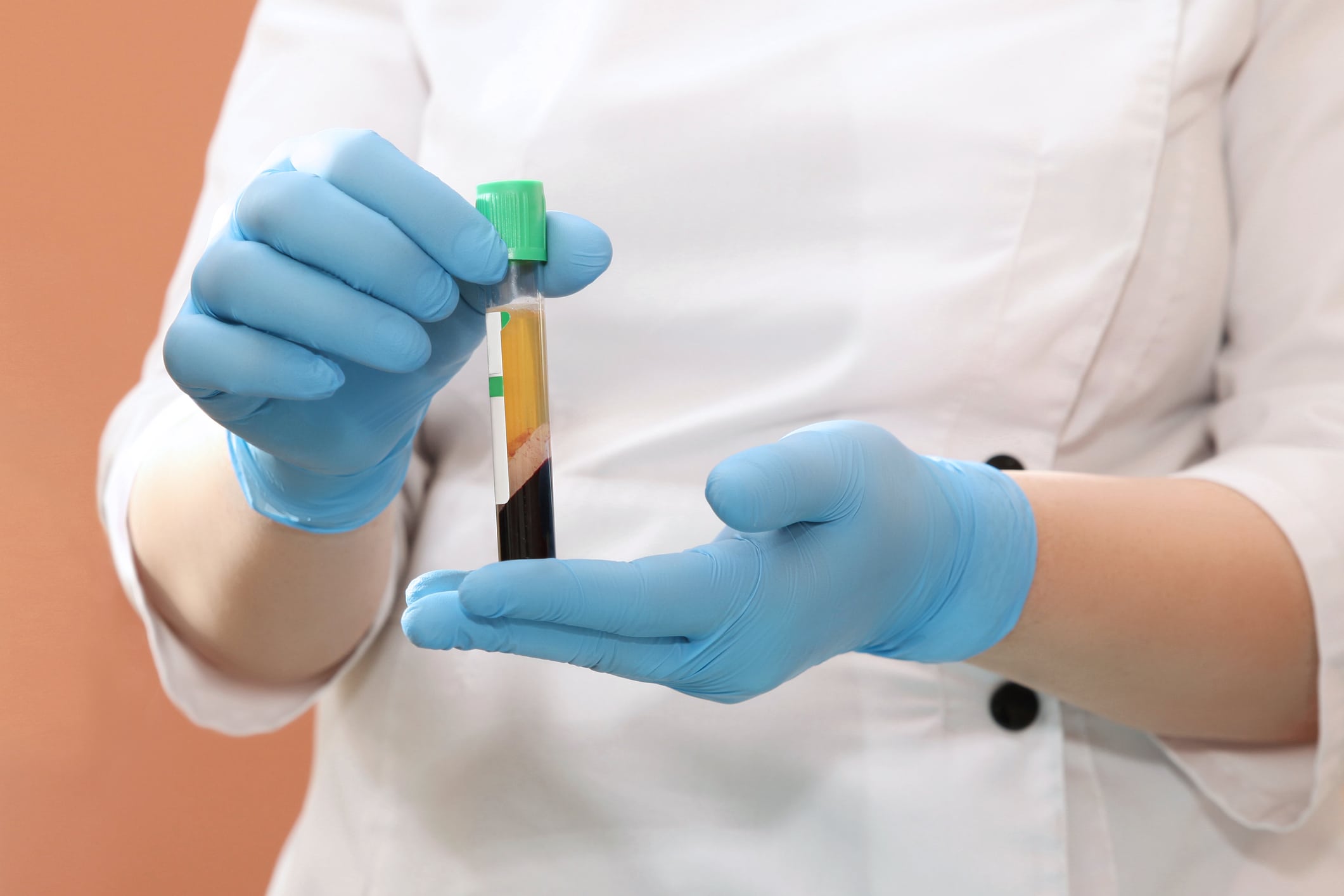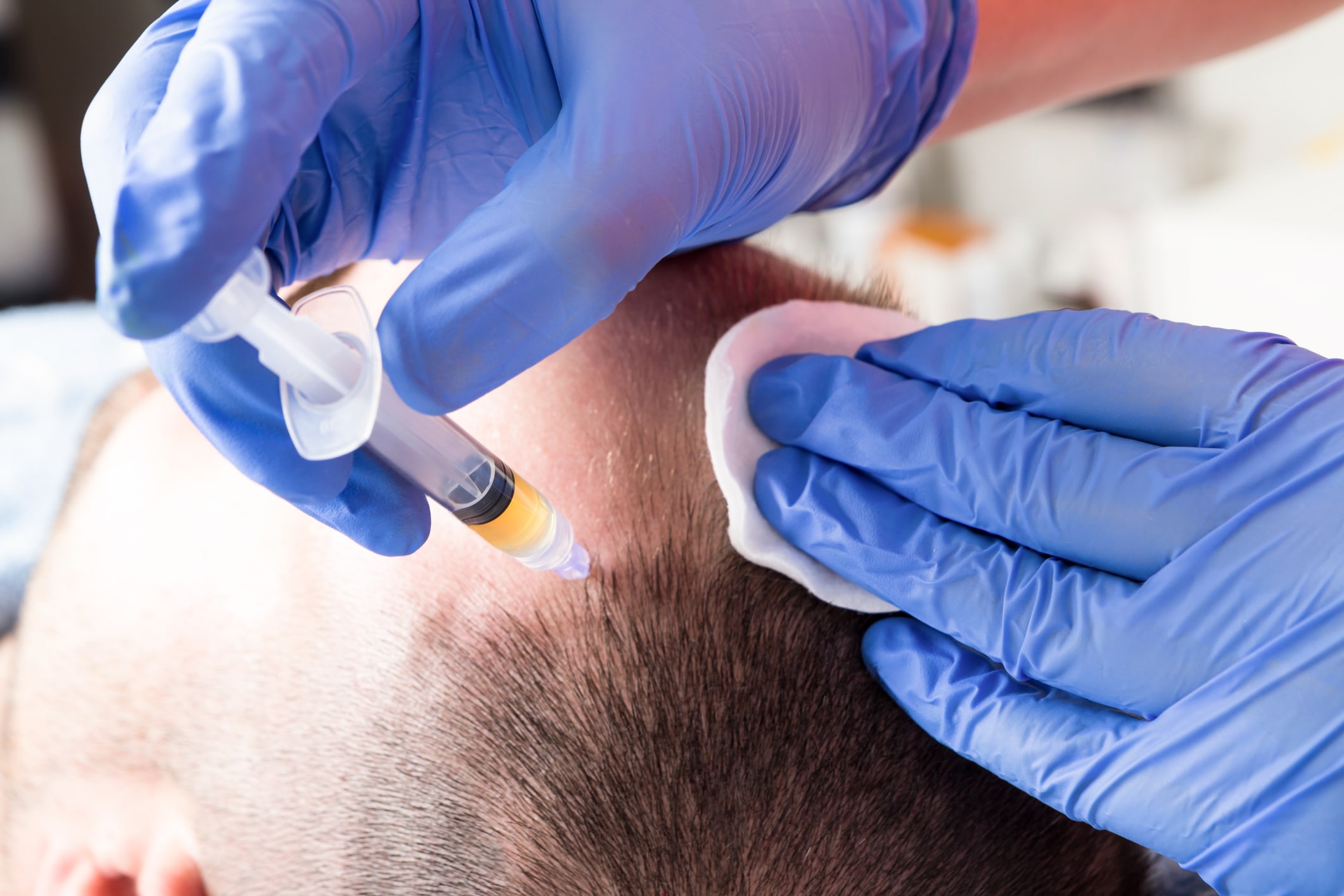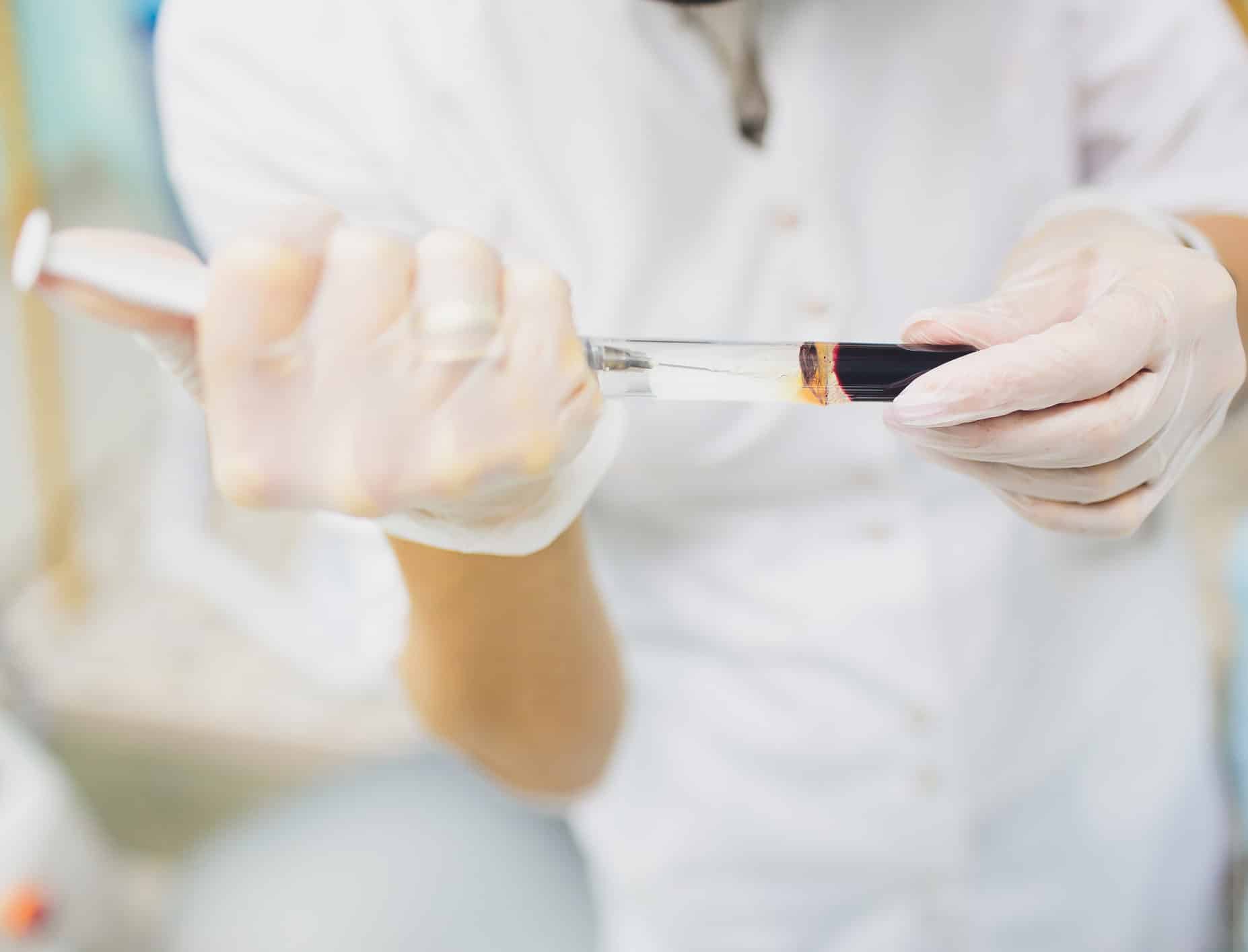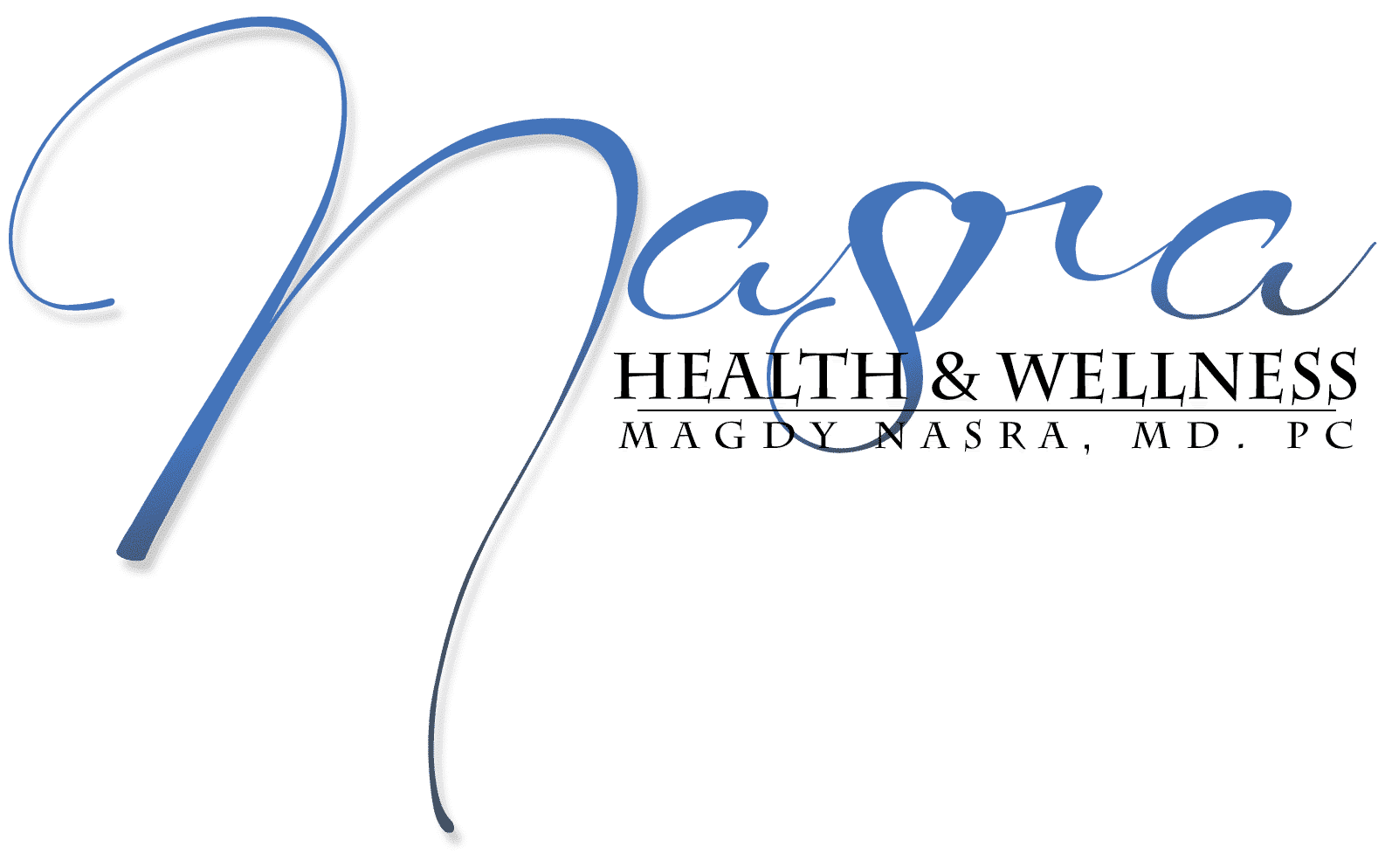What Is PRP?
Platelet-rich plasma, or PRP, is a substance that’s thought to promote healing when injected. Plasma is a component of your blood that contains special “growth factors,” or proteins, that help your body promote healing. It also contains proteins that support cell growth to help repair damaged tissues. Clinicians are able to produce PRP by isolating the plasma which contains several types of growth factors from blood and concentrating it. This is accomplished trough a small blood and takes about 12 minutes to isolate platelet rich plasma.

The idea is that injecting PRP into damaged tissues will stimulate your body to grow new, healthy cells and promote healing. By concentrating growth factors physicians are able to utilize PRP to target the body’s various tissues help patients heal faster.
Uses Of PRP Injections
Clinicians use PRP injections across a number of applications. Examples of these include:
- Hair loss: Doctors have injected PRP into the scalp to promote hair growth and prevent hair loss. According to research PRP injections are effective in treating androgenic alopecia, which is also known as male pattern baldness.
- Microneedling:Also known as collagen induction therapy or percutaneous collagen induction, is an increasingly popular treatment modality for skin rejuvenation. The approach employs small needles to puncture the skin and stimulate local collagen production in a minimally invasive manner. Recently, clinicians have incorporated the use of platelet-rich plasma (PRP) with the aim of augmenting cosmetic outcomes. Treatment with microneedling promotes skin rejuvenation by creating small puncture wounds in the epidermis and dermis. This injury triggers the wound healing cascade and alters the modulation of growth factors to promote regenerative effects.
Following microneedling therapy, increases occur in elastic fiber formation, collagen deposition, and dermal thickness. The utilization of PRP in conjunction with microneedling procedures appears to promote further faster healing and the promotion of collagen formation. - Post CO2 Ablative Laser:PRP is prepared and applied post CO2 to promote healing and reduce downtime.
- Facial Injections:In aesthetics, PRP is commonly utilized for facial rejuvenation through injections.PRP is often used in conjunction with an HA dermal filler or with fat for volumizing.PRP promotes healing and helps aid in the regeneration of new cellular growth and helps to revive damaged tissues.
- Tendon injuries: Tendons are tough, thick bands of tissue that connect muscle to bone. They are usually slow to heal after injury. Doctors have used PRP injections to treat chronic tendon problems, such as tennis elbow, Achilles tendonitis at the ankle, and jumper’s knee, or pain in the patellar tendon in the knee.
- Acute injuries: Doctors have used PRP injections to treat acute sports injuries, such as pulled hamstring muscles or knee sprains.
- Postsurgical repair: Sometimes doctors use PRP injections after surgery to repair a torn tendon (such as a rotator cuff tendon in the shoulder) or ligaments (such as the anterior cruciate ligament, or ACL).
- Osteoarthritis: Doctors have injected PRP into the knees of people with osteoarthritis. A 2015 study found that PRP injections were more effective than hyaluronic acid injections (a traditional therapy) for treating osteoarthritis. However, the trial was a small group of 160 people, so larger trials are needed for this to be conclusive.
It’s important to note that none of these uses have been definitively proven to provide results.
Benefits Of The PRP Treatment
There are several appealing aspects of PRP treatment, including:
- Minimal discomfort. To get PRP, one does not have to go under general anesthesia or get incisions. The extent of the invasiveness of PRP treatments is the blood draw that is conducted to obtain platelets.
- Safety. PRP usage is very safe. This is because the product is in the blood cells. Blood is taken from the arm, processed to separate PRP, and reinjected into the body for specific results.
- Effectiveness. The results of PRP treatment occur gradually but continue to improve for up to 12 months.
- Convenience. There is no need to take time off work to undergo PRP treatments. Patients can drive to and from their appointment because no sedatives or anesthesia is used during the procedure.
- Versatility. Because growth factors do important work in the skin and other structures of the body, PRP has been used in a variety of areas, including orthopedic medicine, aesthetics, and hair restoration.
How Does PRP Work?
There are more than 30 bioactive proteins contained in platelets, each with a certain capacity to heal tissue. Additionally, platelets secrete several growth factors, which trigger wound healing responses. Some of the proteins that are contained in PRP encourage cells to tether to one another, further supporting an optimal healing response. By introducing PRP into an area that has not been wounded, we encourage a cascade of regenerative processes that are intensified several times over. An example of what PRP does in the skin or other area is to decrease the number of inflammatory cells and enhance cellular growth while simultaneously activating the rebuilding of soft tissue or bone.
What Is PRP For Hair Loss?
The regenerative qualities of PRP are well-suited to early hair loss. Introducing platelets into the scalp or other areas in which hair is thinning stimulates a vascular response in which circulation to dormant hair follicles increases. The numerous healing proteins in PRP also energize “lazy” hair follicles to engage in a stronger active growth phase.

What Causes Hair Loss In Women?
Like male pattern baldness, there is a genetic factor for some women who experience hair loss. This is referred to as androgenetic alopecia, or female-pattern baldness. This condition can be seen in family lines and may begin at any time in a woman’s life, starting in adolescence. In female-pattern baldness, hair loss occurs as diffuse thinning.
An additional reason for hair loss in women is traumatic alopecia, which is related to hairstyling. This type of alopecia may result from chemicals in hair dyes or straighteners or from excessive heat or styles that are extraordinarily tight and pull on the hair.
What Causes Hair Loss In Men?
Male pattern baldness, referred to as androgenetic alopecia, is a genetic condition that is passed down from a parent. Male pattern baldness is the most common type of hair loss for men.
Both men and women may experience hair loss due to other factors, including:
- Stress
- Poor diet
- Anemia
- Thyroid problems
- Certain medications
- Infection in the scalp
- Alopecia areata can cause extensive hair loss that begins with round bald patches
- Cicatricial alopecia involves the development of scar tissue in hair follicles that prevents hair growth
Who Is The Perfect Candidate For PRP Hair Loss Treatment?
PRP may be an ideal treatment for those who have begun to notice poor quality hair growth but who still have functioning hair follicles. The PRP procedure may also be beneficial for individuals with bald spots caused by alopecia areata.
What Is PRP Facial Rejuvenation?
In the same way that platelet-rich plasma can stimulate hair follicles, it can encourage more youthful behavior in the skin. There are two common techniques used for PRP facial rejuvenation. One is to combine platelets with a microneedling technique and the other is to inject PRP as its own type of dermal filler.
The various dermatologic processes that keep the skin looking young are enhanced by PRP. This can improve radiance, volume, and texture over time. The proteins contained in platelets assist in the regeneration of the fibrin polymer matrix in the skin. The substance promotes increased circulation and also feeds the skin with electrolytes and healing growth factors.
How To Prepare For PRP Treatment
Generally speaking, there are few steps to preparing for PRP injections. Basic preparation includes a venous blood draw consisting of approximately 10ml-60ml of blood. This specimen is then centrifuged to separate the plasma and various blood components. This blood collection is performed utilizing sterile kits to minimize the potential for any infections.
What To Expect During Treatment
Here’s what to expect from a typical PRP injection process:
A healthcare professional will draw a sample of your blood. The amount of the sample depends on the procedure and where the PRP will be injected. The blood is placed into a centrifuge. This is a machine that spins around very quickly, causing the blood components to separate. The separation process takes approximately 10-15 minutes.

A technologist then takes the separated plasma and prepares it for injection into the affected area. Doctors will often use imaging, such as ultrasound, to pinpoint specific areas for injection, such as the tendon. Your doctor will then inject the PRP into the affected area.
How Long Is PRP Treatment?
Each treatment can take between 1 and 1 ½ hours. This accounts for the application of topical anesthetic, if needed, the collection of blood product and processing of the blood to obtain PRP, and the treatment itself.
Is PRP Painful?
PRP treatments may begin with the application of a topical numbing medication. This occurs approximately 30 minutes before microneedling or injections are administered. By the time we commence with treatment, the area is desensitized and should feel only minor sensations, if any.
PRP can be injected in different ways. For example, PRP is utilized for musculoskeletal injuries, soft tissue injuries, hair restoration, facial rejuvenation, as well as sexual dysfunction conditions. Pain thresholds vary amongst patient depending on the application but typically patients experience very little discomfort from the PRP. Sometimes a topical numbing lidocaine solution is applied to a patients treatment area before injection to reduce discomfort. Other times, a local anesthetic is mixed with the PRP to reduce any discomfort.
What To Expect During Recovery
When PRP is injected following injury, your doctor may recommend that you rest the affected area. However, these recommendations are more related to the injury and less to the PRP injections. Most people can continue their daily activities following PRP injections.
It’s typical that multiple treatments will be necessary to receive complete benefits. For most aesthetic treatments 3-6 treatments are typically necessary over the course of several months. Your physician will evaluate and recommend a customized program tailored to you individual needs.
How Much Does PRP Cost
According to the American Academy of Orthopaedic Surgeons, very few insurance plans will provide any reimbursement for PRP injections. The costs must largely be paid out-of-pocket. The costs can also vary from location to location and on how the injections are used. Some of the reported costs nationwide include the following:
ABC News 7 in San Francisco reports PRP treatments for hair loss cost $900 for one treatment with one vial of PRP. There usually discounted treatments when purchased as a package.
The Washington Post reports that knee injections of PRP can cost anywhere from $500 to $1,200 per treatment.
Insurance companies consider PRP an experimental treatment. More scientific research will have to conclude its effectiveness before it is more widely covered.
Side Effects Of PRP
Because PRP involves injecting a substance into the skin, there are potential side effects. PRP is autologous, which means that it comes directly from your own body and there is no chance of rejection.
However, there are risks from the injection itself, including:
- infection
- nerve injuries
- pain at the injection site
- tissue damage
You should discuss these potential risks with your doctor, as well as the steps your doctor will take to minimize these risks.
Dr. Nasra Also Serves The LGBT Communities
Dr. Nasra believes quality healthcare needs to be given to anyone, regardless of who they are. We value a comprehensive approach to LGBTQ patient care where we aim to provide quality, evidence-based healthcare that comes from a non-judgemental, and open-minded approach. We strive to maintain a safe, stigma-free and welcoming space for every patient.
Schedule A Consultation
To learn more about PRP please contact our office today at 732-888-8255 to schedule an appointment. Our practice serves Holmdel, NJ and the surrounding areas.
